SST Colombia Fieldnotes pt.1
This is the first in a series of blogs documenting the ongoing SST research in Colombia, mainly focused on picó culture. Not claiming to be comprehensive or authoritative, what follows is rather the result of several conversations, meet ups, and explorations that happened over a preliminary research trip in December 2022 aimed precisely at doing networking and building research links in different parts of the country. One of the ways SST aims to make its research accessible is to share the research process in this manner. For both this series of blog and the Colombia research we must acknowledge the generosity of several people within and around the picó and sound system culture who have been keen to share their incredible knowledge and have provided us with a very needed door to access an incredibly rich, fascinating, and often stigmatized culture. Shouts out to: Ricardo Vega of El Gran Latido sound system; Urabá Sound System collective (Miladis Cordoba, Willington Albornoz and Rafa Master); Edgar Benitez aka Dr Tiger: JJ Carbonell aka Contropiano; Monosoniko Champetudo; Lucas Silva of Palenque Records; Don Alirio; Camilo Alarcón of Palenque Sonoro; Loco Qua Qua of El Son Caribe; and many others…
by Brian D’Aquino
Doing field research in popular culture is first and foremost a learning process which involves challenging one’s own existing knowledge and the way it is articulated, repositioning oneself to be able to connect to different traditions and lifeways. Running a reggae sound system for nearly twenty years (Bababoom Hi-Fi, based in Naples, Italy) gave me some insight into other SST cultures around the world, as well as an established network of contacts in different continents. It also provided a sort of benchmark for this provisional exploration of Colombian picó culture. In this sense, the richness of the music landscape, the depth of the social engagement, and level of technological sophistication have been absolutely impressive, especially considering the comparatively small global diffusion of this sonic street technology, which has remained exclusive to a few regions of Colombia until very recently [1].
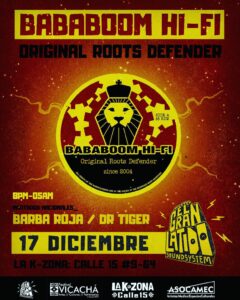
Poster for Bababoom Hi Fi, El Gran Latido, Dr Tiger, Barba Roja, Bogotà 2022
Sound systems also provided my first link to Colombian popular music and SST culture via Ricardo Vega owner of El Gan Latido, a reggae sound system from Bogotà currently at the forefront of the Latin America sound system explosion. El Gran Latido is doing some very inspirational work using his machine to amplify social and political struggles, as he was able to share as part of SSO#7, online (see event archive). It must be added that Ricardo spent his formative years in Italy, where he was involved with the autonomous social movement, the massive rave scene and the student protests that were very lively in between the late 1990s and the mid 2000s. This inspired him to establish El Gran Latido. Sharing a similar background in terms of underground politics and culture immediately allowed me to feel pretty much in tune with what El Gran Latido does, as I could experience firsthand when I was invited to play in Bogotà in December 2022. Ricardo is also very committed to building links between the different SST scenes in Colombia, such as the long established picó culture and the rising reggae dub sound system scene. His contacts allowed me to travel the country and learn more about picó culture.
A People’s Culture
With over six decades of history, the picó can be described as the local cultural institution of the Colombian Caribbean coast. Its most known epicentres are the cities of Barranquilla and Cartagena and, to a lesser extent, Santa Marta. Another less known cradle of the picó culture is the city of Turbo in the Urabá region. Due to the region’s geographical isolation and long history of endemic violence, this remains very little acknowledged even in Colombia (see this blog).
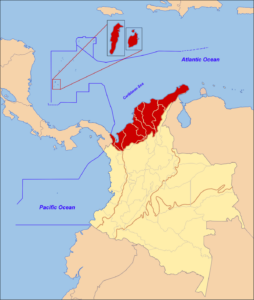
Colombian Caribbean Region is home to picó culture
Like other SST cultures around the world, the picó originates from the need for self-expression and cost-effective entertainment among marginalised sectors of society, particularly black and brown working-class people, who could negotiate their own identity by drawing from a rich musical repertoire. This initially included African music, especially soukous, highlife, afrobeat and juju, among other genres; it later progressed to include salsa, vallenato, and various Caribbean and Latin American rhythms reflecting the composition of a very diverse country, and eventually evolved into an indigenous music genre, champeta. The music diversity is probably the most striking feature of picó culture. This was acknowledged by several of the people I met, who proudly claimed that picós were playing ‘world music’ long before the (Western) music industry even coined the term.
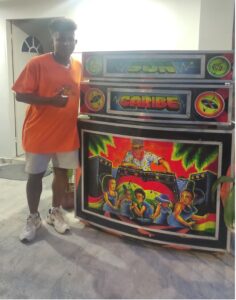
Son Caribe with owner Loco Qua Qua, Santa Marta
As noted by researcher and DJ Dr Tiger, the picó has also been instrumental for a collective negotiation of the Afro Colombian identity in the Caribbean Coast region. By playing African music, picós helped ‘Africa’ as a cultural signifier to enter the local cultural space and be shared, reinterpreted, appropriated, and finally accepted, by a population who had tended to identify more as mixed race than Black.
As a matter of fact, on the road that runs in between Cartagena, Barranquilla and Santa Marta almost every shop, bar or poolroom is equipped with a small to medium-sized sound system, blasting very loud music for the pleasure of patrons who tend to sit very close to the speakers while having a beer or play billiards (chatting being quite a difficult task given the decibel levels). But these should be considered more as domestic picós, or picócitos, as I quickly learned. In fact, a real picó needs three main features to be named as such: a name, a well-curated music selection including exclusive tunes and placas (vocal samples), and a pintura (unique handmade painting – or at least a logotype).
The Turbo Set
The traditional picó set, often called turbo, is made of one hand-painted and hand-crafted wooden cabinet where several speakers are allocated, usually providing for the low and mid frequencies. This is often complemented by one or more smaller boxes dedicated to the high frequencies. Back in the days, even smaller top boxes were in use, to be placed around the dancefloor to disseminate sound more efficiently, in a way similar to the infamous steel horns that Jamaican sound systems used to hang in the trees to be heard miles away.
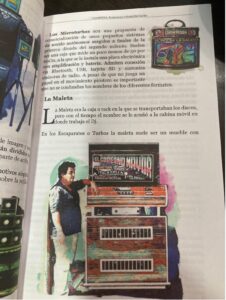
Image from the book Champeta: Resistencia Cultural del Caribe (Carbonell 2022).
The pintura is a very distinctive feature of picó culture. Hand-painted using fluorescent colours and purposedly illuminated during dances, each pintura is a unique work of art that represents the picó’s name and, therefore, its identity. This is traditionally realized on a cañamazo (cotton canvas) which covers the turbo front, also protecting the speakers from dust and heat. Interestingly, the cañamazo size rarely exceeds 1,5x2m, which in turn affects the maximum size of the turbo cabinet, as Cartagena-based journalist JJ Carbonell pointed out. William “El Maestro” Gutiérrez is one of the most acclaimed painters in the scene, with a career spanning over few decades and hundreds of unique works realized so far. With fraccionados, the cañamazo is usually replaced by a metal grill, often painted with a logotype rather than a full artwork, but using the same fluorescent colours.
Barranquilla is usually acknowledged as the cradle of traditional picó technology and culture, and it is home to the first generation of renowned sound engineers and speaker builders, as many of my contacts explained. Colombia’s main port city, Barranquilla used to be the door through which sound technology entered Colombia, as testified by the country’s first private radio station, HKD/ La Voz de Barranquilla, established in 1929, which prompted the diffusion of domestic radios in the decades prior to World War II. By chance, radios in Barranquilla were also able to catch signal from Cuban stations [2]. Together with the import of African records that were actively traded by sailors, this quickly turned Barranquilla into the music capital of Colombia for the first half of the XX century, with the repertoire of the first Colombian orchestras reflecting a variety of music influences spanning from Congo, South Africa and Nigeria to Cuba, Puerto Rico, New York and beyond (see also this blog by Camilo Alarcón and Alexandra Bejarano).
Technology and Culture
Historically, technological repurposing has been an important feature of the culture. In the 1960s and 1970s most of the high-quality equipment such as amplifiers and speakers employed by the main picós would be sourced from theatres and ballrooms in Barranquilla. These were adapted by picó owners to suit their sets. As time and technology progressed, the same components would be sold again to smaller picós operating in the city outskirts or in small villages, thus originating a spread-out movement of pre-owned sound technology. The maintenance and build-up of picós has slowly originated a relatively big industry on the Colombian Caribbean Coast, with a few established engineers, builders and painters highly in demand. Especially in the 1980s, engineers were a very renowned figure, to the point that it was not uncommon to see their name advertised on dance posters together with that of the picó hosting the dance.
As technology evolved and the need to cater for bigger audiences increased, many picós gave up the traditional turbo format for a more contemporary set up called fraccionado (‘split’). This consists of several boxes piled up to form a stack, in a way that resembles the classic sound system set up. In a similar way, amplifying technology also evolved from valve (tubos), which were predominant until the 1980s, to transistor amps.
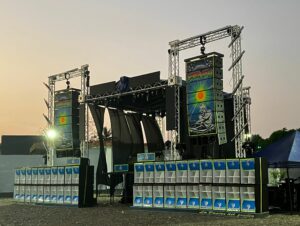
Firu DJ full set in Turbo.
Nowadays, the main Colombian picós are massive technological and financial enterprises employing huge line array systems and world-class digital amplifiers, also providing lighting, projection screens, truss systems and stages, in a way that resembles PA companies. This is the case of El Rey De Rocha from Cartagena or Firu DJ from Turbo, whose events regularly attract an audience of thousands. But due to their history, the music they play, and the following they gathered over the years – in one word: their identity – they are indisputably acknowledged as picós.
During the last ten to fifteen years there has been an unexpected resurgence of the classic turbo format and aesthetics. This is apparently due to a mix of different factors, such as the rising tourist and hospitality industry in Barranquilla and Cartagena, with the traditional turbo aesthetics appealing to visitors, as well as the online attention generated by blogs such as Africolombia by Fabian Altahona, which consolidated a relevant online archive of what was (at the time) a nearly wiped-out culture. Not least, the increasing criminalization of the verbenas (street dances) also played a role.
Criminalization and Stigma
Since at least the early 2010s, severe restrictions on picós playing in public spaces have been implemented both in Barranquilla and in Cartagena city centers, including on weekends and during festivities, with an attempted picó ban even during Carnival in Barranquilla. This pushed picoteros to relocate to the suburbs, or to private venues such as bars and poolrooms, and in turn to scale down the size and power of their equipment, as noted by Santa Marta-based DJ and cultural activist Monosoniko (see also this interview to El Timbalero owner).
As a matter of fact, for the Colombian middle classes picó culture generally carries a deeply rooted stigma. Not only authorities and elites tend to associate street dances and their audience with crime, therefore calling for more stringent regulations. More surprisingly, even most of the taxi drivers, hotel workers, and passers-by I met tended to refer to these events as unsafe gatherings of dodgy individuals prone to drunkenness and violence – something that both right-minded Colombians and foreigners should definitely avoid. Many also blamed the high decibel levels and the absence of sound regulations as source of considerable nuisance in the neighbourhood.
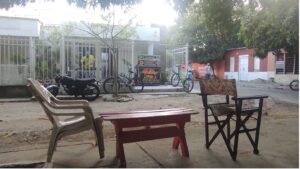
Son Caribe playing from the patio to avoid being seized by the police in Santa Marta.
Despite the recent resurgence and a growing attention from abroad, picós remain a cultural expression of the lower strata of Colombian society. Common to many other sonic street technologies (see for example this blog about Mexican sonideros by Linette Rivera), the cultural stigma relies on a notion of public policy that is deeply intertwined with class and colour divide. In the urban space, this tension can be further exacerbated by the Airbnb-driven exponential rise of the tourist industry. While marketing a sanitized version of the popular culture to visitors and middle-class citizens, this contributes to remove working class people’s culture and lifeways from the city centre in favour of more profitable and law-complying businesses.
In such a challenging context, it might be important for SST practitioners to create collectives, professional associations, and platforms to have their voice amplified in order to build a dialogue with the authorities and ensure that their culture remains part of both the country’s cultural landscape and the city’s soundscape. In Barranquilla, Cartagena and Santa Marta exist professional associations gathering picoteros and industry professional in a way similar to what the Jamaica Sound System Federation and others have been doing in Jamaica (see this blog). This is also what has been happening in Apartadò and Turbo thanks to the initiative of the Urabà Sound System Collective, whose critical work SST has been trying to support, as will be reported in the next blogs.
References
[1] In the last few years a handful of picós have started to pop up out of Colombia, such as El Gran Mono (Australia), El Maradona (Italy) and La Luz Verde in Spain, about to be launched.
[2] On the history of the radio in the Caribbean see also Bronfman, A. 2019. “Radio Wars and Revolution in the Caribbean, 1959”. Journal for Media History 22 (2), 87-96.
